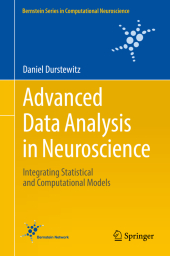 Neuerscheinungen 2017Stand: 2020-02-01 |
Schnellsuche
ISBN/Stichwort/Autor
|
Herderstraße 10
10625 Berlin
Tel.: 030 315 714 16
Fax 030 315 714 14
info@buchspektrum.de |

Daniel Durstewitz
Advanced Data Analysis in Neuroscience
Integrating Statistical and Computational Models
1st ed. 2017. 2017. xxv, 292 S. 10 SW-Abb., 66 Farbabb., 66 Farbtabellen. 235 mm
Verlag/Jahr: SPRINGER, BERLIN; SPRINGER INTERNATIONAL PUBLISHING 2017
ISBN: 3-319-59974-7 (3319599747)
Neue ISBN: 978-3-319-59974-8 (9783319599748)
Preis und Lieferzeit: Bitte klicken
This book is intended for use in advanced graduate courses in statistics / machine learning, as well as for all experimental neuroscientists seeking to understand statistical methods at a deeper level, and theoretical neuroscientists with a limited background in statistics. It reviews almost all areas of applied statistics, from basic statistical estimation and test theory, linear and nonlinear approaches for regression and classification, to model selection and methods for dimensionality reduction, density estimation and unsupervised clustering. Its focus, however, is linear and nonlinear time series analysis from a dynamical systems perspective, based on which it aims to convey an understanding also of the dynamical mechanisms that could have generated observed time series. Further, it integrates computational modeling of behavioral and neural dynamics with statistical estimation and hypothesis testing. This way computational models in neuroscience are not only explanatory frameworks, but become powerful, quantitative data-analytical tools in themselves that enable researchers to look beyond the data surface and unravel underlying mechanisms. Interactive examples of most methods are provided through a package of MatLab routines, encouraging a playful approach to the subject, and providing readers with a better feel for the practical aspects of the methods covered.
"Computational neuroscience is essential for integrating and providing a basis for understanding the myriads of remarkable laboratory data on nervous system functions. Daniel Durstewitz has excellently covered the breadth of computational neuroscience from statistical interpretations of data to biophysically based modeling of the neurobiological sources of those data. His presentation is clear, pedagogically sound, and readily useable by experts and beginners alike. It is a pleasure to recommend this very well crafted discussion to experimental neuroscientists as well as mathematically well versed Physicists. The book acts as a window to the issues, to the questions, and to the tools for finding the answers to interesting inquiries about brains and how they function."
Henry D. I. Abarbanel
Physics and Scripps Institution of Oceanography, University of California, San Diego
"This book delivers a clear and thorough introduction to sophisticated analysis approaches useful in computational neuroscience. The models described and the examples provided will help readers develop critical intuitions into what the methods reveal about data. The overall approach of the book reflects the extensive experience Prof. Durstewitz has developed as a leading practitioner of computational neuroscience. "
Bruno B. Averbeck
Statistical Inference.- Regression Problems.- Classification Problems.- Model Complexity and Selection.- Clustering and Density Estimation.- Dimensionality Reduction.- Linear Time Series Analysis.- Nonlinear Concepts in Time Series Analysis.- Time Series From a Nonlinear Dynamical Systems Perspective.
Daniel Durstewitz is Professor for Theoretical Neuroscience and Head of the Department of Theoretical Neuroscience at the Central Institute of Mental Health, Mannheim, and the University of Heidelberg. He is also the coordinator and a director of the Bernstein Center for Computational Neuroscience Heidelberg-Mannheim. He has authored numerous articles in the fields of theoretical and computational neuroscience, applying and advancing various statistical and modeling techniques. Together with Jeremy Seamans, he has also developed an influential computational theory of dopamine function in the prefrontal cortex.


